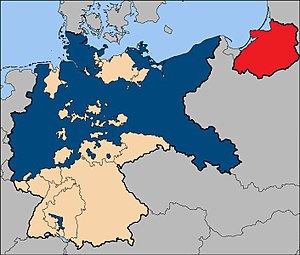Evacuation of East Prussia
| Evacuation of East Prussia | |||||||
|---|---|---|---|---|---|---|---|
| Part of World War II | |||||||
|
East Prussia (red), was separated from Germany and Prussia (blue) proper by the Polish corridor between World War I and World War II. The area, divided between Russia and Poland in 1945, is 340 km east of the present-day Polish–German border |
|||||||
|
|||||||
| Belligerents | |||||||
|
|
|
||||||
| Commanders and leaders | |||||||
|
|
|
||||||
| Casualties and losses | |||||||
|
|
|||||||
The evacuation of East Prussia was the movement of the German civilian population and military personnel in East Prussia and the Klaipėda region between 20 January and March 1945 as part of the evacuation of German civilians towards the end of World War II. It is not to be confused with the expulsion after the war had ended, under Soviet occupation.
The evacuation, which had been delayed for months, was initiated due to fear of the Red Army advances during the East Prussian Offensive. Some parts of the evacuation were planned as a military necessity, Operation Hannibal being the most important military operation involved in the evacuation. However, many refugees took to the roads on their own initiative because of reported Soviet atrocities against Germans in the areas under Soviet control. Both spurious and factual accounts of Soviet atrocities were disseminated through the official news and propaganda outlets of the Third Reich and by rumors that swept through the military and civilian populations.
Despite having detailed evacuation plans for some areas, authorities of the Third Reich, including the Gauleiter of East Prussia, Erich Koch, delayed action until January 20, when it was too late for an orderly evacuation, and the civil services and Nazi Party were eventually overwhelmed by the huge number of those wishing to evacuate. Coupled with the panic caused by the speed of the Soviet advance, civilians caught in the middle of combat, and the bitter winter weather, many thousands of refugees died during the evacuation period. The Soviets took complete control of East Prussia in May 1945. A large part of the German civil population of about 2.5 million managed to evacuate, though about 25,000–30,000 were killed during the Soviet offensive. In May 1945 Soviet authorities registered 193,000 Germans in East Prussia but an estimated 800,000 managed to return after the end of hostilities, most of whom were later forcibly expelled by the Soviet and Polish authorities. The Polish census of 1950 indicated that 164,000 of the former German population remained in Southern East Prussia. Most later emigrated to Germany.
...
Wikipedia

